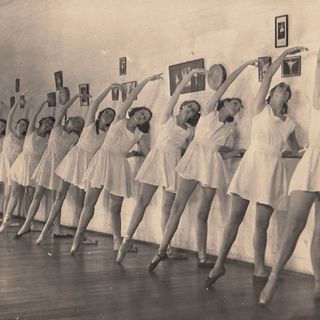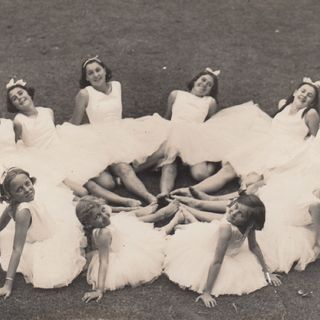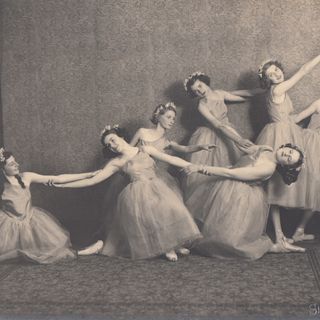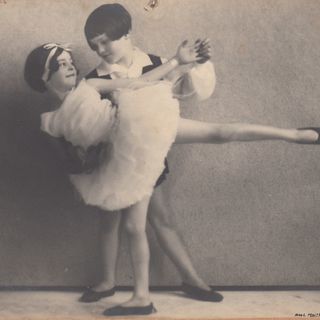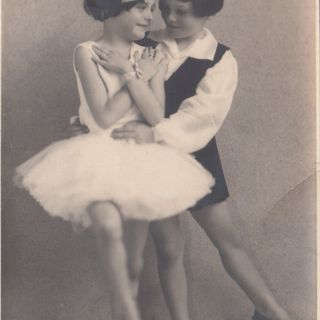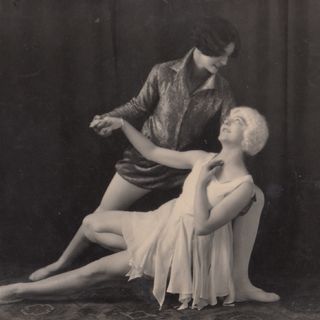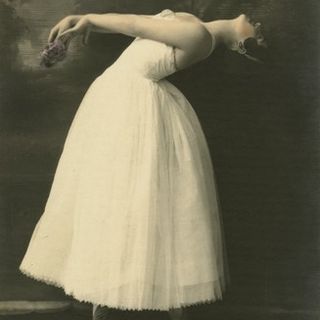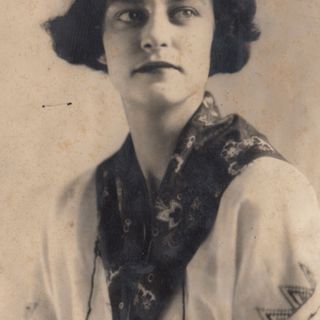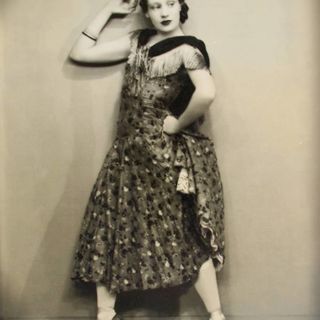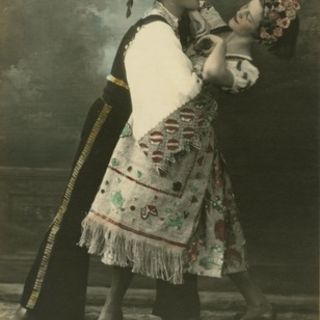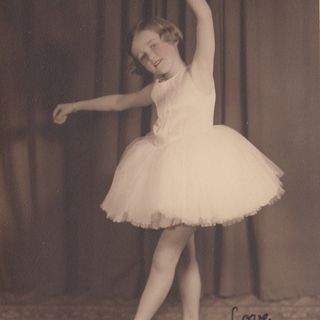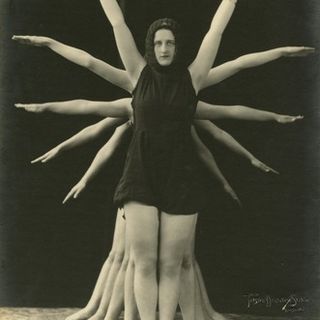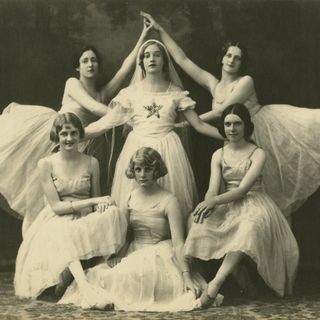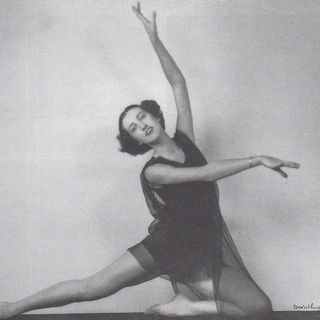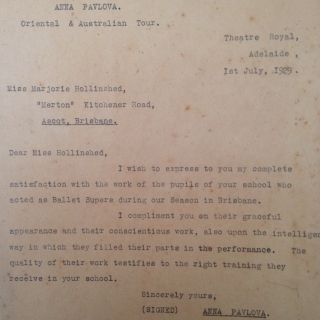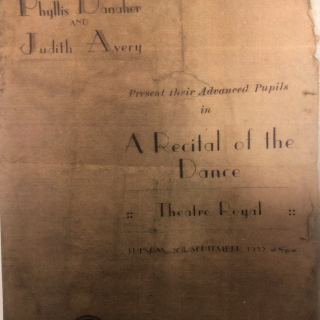
Genesis of Ballet Theatre of Queensland
Miss Phyllis Danaher seizes a great opportunity for Queensland dance
In 1937 renowned Sydney dance teacher Frances Scully founded the Australasian Society of Operatic Dancing (ASOD) and Brisbane teacher Phyllis Danaher, seeing the merits of such an association for teachers and students, immediately established the society’s Queensland Branch.
At its inaugural meeting on 22 March 1937, attended by 11 members, Miss Danaher was elected President, her close colleague Clare O'Bryen was Secretary and Gwen Slater was Treasurer. At the outset membership was quite exclusive, limited to dancers and teachers who had passed a major R.A.D. exam.
In 1938 the Queensland Branch had enough members to form a full committee but just as the association was starting to grow, World War Two was declared forcing the society into recession from 1942 to 1946. In 1947 it was active again under the presidency of Brenda McCullough who gave up her own school to dedicate her time and energies to the society, which she did, as President, for the next nine years.
Until 1953 the society concentrated on supporting talented Queensland dancers. To this end teachers gathered together to give recitals of their students’ work for the express purpose of raising money for overseas scholarships of £400 tenable to a London ballet school. Lucky recipients were Patricia Macdonald of the Bassett School, Donald Kingston of the Elsie Seguss School, and Margaret Lee Andrews of the Pat Mead School. In those early years, the students who participated in the recitals were from the studios of Danaher & O’Bryen, Daphne Sapsford, Pat Mead, Elsie Seguss, and Joy Bassett.
Ever the change-agent, Miss Danaher thought the time might be right for a paid artistic director to be appointed to produce ballets for the society. She thought immediately of her former pupil Cyril Johns who had been dancing for six years with the International Ballet Company, a British touring company. And he said ‘yes’, and stayed until 1961. While this appointment in 1953 put a stop to individual overseas scholarships it gave professionally-directed experiences to many aspiring dancers.
On his arrival, Johns immediately set about creating a theatre group which he named Brisbane Ballet Theatre. On 26 October 1953 the group presented their inaugural production of Swan Lake, Act 2 at the Albert Hall with a cast of 19 led by soloists Ruth Ellis and Cyril Johns. It was an unusual night as the program was shared with the Brisbane Arts Theatre who presented a performance of Noel Coward's play Hands Across the Sea. The event was an overwhelming success.
By 1954 the ASOD had ceased to exist in other states so the Queensland branch membership voted to become an independent organisation to be called the Queensland Ballet Society and open to all.
The following year Brisbane Ballet Theatre (now a subsidiary to the Queensland Ballet Society) presented its first complete performance event, with a small live orchestra, at the City Hall. Cyril John’s ambitious 1955 program included Swan Lake, Act 2; Valse de Fleur from The Sleeping Beauty; Pas de Trois from Swan Lake, Act 1; and Coppelia, Act 3. In his program notes, Johns stated that his “aim in the Ballet Theatre is to form a link between the Ballet Student and the Professional Ballet Stage, and also to foster and develop the Art of Ballet in Queensland.”
In the same year Edouard Borovansky agreed to become Patron of the Society, a strong indication that QBS had set its sights and its standards high. As its 1956 program stated, the organisation had been formed “for the cultural development of Ballet in Queensland and a greater appreciation of the Art and its execution by presenting Queensland-trained artists in their own productions of the Classics.” From 1955 on membership grew annually, more ballets were presented, and more students were accepted into recognised ballet companies.
Additionally a great incentive for young dancers was a new scholarship of £100 for training at the Borovansky school in Melbourne and judged by Borovansky himself. In 1956 and 1957 it was awarded to Joan Cherry and Meryl Hughes respectively.
Although Cyril Johns resigned in 1961, that year Lexie Kunze from the Borovansky Ballet and experienced dancer and teacher Meryl Hughes directed and danced in an outstanding production of Giselle.
But trouble was brewing. A new group opened its doors - the Queensland Ballet Company, founded by Charles Listner. The similar names caused confusion and unfortunately the Queensland Ballet Society had not thought to register its name. It had no option but to change its name. So in 1962 it chose to call itself Ballet Theatre of Queensland and has been known by that name thereafter.
The following year Phyllis Danaher was appointed Artistic Director. For the next 22 years her ambitious vision and creative skills, alongside hard-working committees - and despite constant financial worries – led BTQ to become renowned for its high quality productions and as an effective launching pad for many young dancers’ careers in some of the finest ballet companies in the world.
Sources
Brissenden, Alan, and Keith Glennon. Australia Dances: Creating Australian Dance 1945-1965. Kent Town, SA: Wakefield Press, 2010.
Hollinshed, Marjorie. In Search of Ballet. Caloundra, Qld: Boolarong Publications, 1987.
Researcher & Writer: Dr Christine Comans
